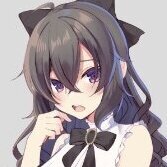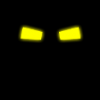Hello, it's nice popping back on one of my first online homes again. Hope all is well. I hope I'm posting in the right forum (admins/mods let me know if I goofed up).
Over the past year or two I've come across a refreshing revision of the Matoran alphabet devised by Kaikue/the-big-kahooner which transforms it into a syllabary writing system, making each "circle" a combination of vowel and consonant. To differentiate between this new system and the classic Latin-based alphabet, I'll refer to the new script as "Matoric".
Basic recap:
And here are examples of diphthongs, with 6 additions to represent all possible combinations:
Despite these being theoretically available, it's possible that some of the extra diphthongs are less practical than just writing the vowels separately ("Toa" for example to be written as "To-a")
And now to the extras:
1. 4 additional vowels created by diagonally aligning the "vowel circles". These sounds can be found in several European languages among others:
2. "Reverse" Diphthongs, wherein the order is flipped and the second component vowel is blacked out to differentiate from the regular diphthongs:
3. Consonants created through depicting existing consonants as being "aspirated":
(I am being rather flexible with this addition as I don't think it accurately depicts the actual linguistic relationship between the sounds. "Sh" for example is not an "aspirated S", and "Kh" could just be an aspirated "K" as in the example "Artakha", though both sounds could exists as belonging to different dialects of Matoric perhaps.)
4. Consonants created by combining existing coda consonants:
5. Punctuation symbols for Matoric:
6. 8 additional consonant[?] symbols created by half-lines, not unlike the long arm of a clock. I'm not sure what these could represent, numbers or even symbols for some of the sounds I've listed above?:
With my additions come obvious issues with readability. For example, writing "dio" using the "io" diphthong would generate this:
The vertical line of the "d" consonant is mostly hidden by the "i" vowel and could be missed. A possible solution to this would be to decrease the size of the "first vowel", in this case the "i":
Here's an example which I took from from the 2021 Matoric booklet (by BZP's very own JRRT) to showcase a simple Matoric sentence:
Monograms:
Monograms to those unaware are symbols "made by overlapping or combining two or more letters or other graphemes to form one symbol". Matoric's structure makes it theoretically possible to create unique symbols for names or concepts, which I've done in 2 different ways.
1. Adding successive syllable circles within each other. For example, "John Cena" (The large black syllable is "Jon" and the two red ones inside are "Sina"):
2. Slapping every syllable circle together forming one single symbol (overlapping vowels can be resized to fit within each other such as the double "a" in the second example of "Makuta"):
I personally find the 2nd method to be quicker as the 1st would require modifying the sizes of each syllable. However, there are instances in which consonants with similar appearances would disappear within each other, such as the name "Kazi":
Combining "Ka" and "Zi" makes the monogram look like it says "Kai", as the "z" essentially disappears from view.
This is where creativity helps add some individuality to one's symbol, such as simply moving the "z" around to symbolise that it's there:
Ultimately, Monograms would probably serve best for signatures and artistic works, as I cannot see an instance in which they would be used in practical writing due to the ambiguity in their pronunciation (I don't think you can't expect most BIONICLE beings to make out your name from a monogram).
There may be cases where they could represent universally-known concepts or beings, in which case they could be used in a manner similar to Kanji in Japanese.
I hope I was more or less understandable and that you've found this an interesting read at the very least.
Credits and MASSIVE thanks to Kaikue and JRRT for their creations and for inspiring me. They're the ones who should be thanked.


